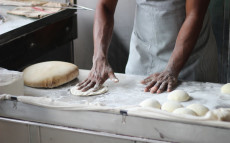- pathfindersAI
- Job Profile
Butchers and Meat Cutters
Summary
The Profession of Butchers and Meat Cutters
What They Do
Butchers and meat cutters are skilled professionals who specialize in the preparation of meat products for retail and wholesale industries. Their expertise ensures that meat is cut, trimmed, and prepared according to the highest standards of quality and safety. These professionals work in a variety of settings including grocery stores, specialty butcher shops, and meat processing plants. The primary goal of butchers and meat cutters is to break down carcasses into consumer-friendly portions, adhering to specific proportions and customer requirements. Their work often bridges the gap between farm and fork, ensuring that consumers receive high-quality, precisely cut meat products.
Job Responsibilities
The responsibilities of butchers and meat cutters are multifaceted and require meticulous attention to detail. Daily tasks include receiving and inspecting meat shipments to ensure they meet safety and quality standards. Professionals meticulously trim excess fat, remove bones, and prepare specific cuts such as steaks, chops, and roasts. They utilize an array of tools ranging from knives and saws to grinders and slicers. Besides cutting meat, butchers and meat cutters also prepare specialty products like sausages and cured meats. Maintaining sanitary work conditions is imperative, therefore, cleaning and sanitizing their workspace and tools is part of their routine. Additionally, they may interact with customers to offer advice and take custom orders, thus requiring excellent customer service skills.
Essential Skills
To excel in the field of meat cutting and butchery, one needs a blend of technical and interpersonal skills. First and foremost, manual dexterity and physical strength are essential due to the demanding nature of the work which involves lifting heavy carcasses and making precise cuts. Attention to detail is critical for creating consistent, high-quality cuts. Knowledge of different meat cuts and animal anatomy is beneficial for efficiency and accuracy. Additionally, butchers must possess strong organizational skills to manage inventory and ensure freshness. Communication skills are crucial for working effectively with colleagues and assisting customers. Familiarity with food safety regulations and proper sanitation techniques ensures adherence to health standards.
Educational Pathways
Entering the profession of butchery and meat cutting typically does not require formal academic qualifications; however, a high school diploma or GED is often the minimum requirement. Prospective butchers can gain initial experience through on-the-job training, which provides practical skills and knowledge. Some employers might offer apprenticeships, which combine hands-on experience with structured learning. Additionally, vocational schools and community colleges offer specialized programs in meat cutting, providing a more comprehensive understanding of the craft. Certifications in food safety and handling, often available through courses or online platforms, can enhance employability and career development.
Career Prospects
The career outlook for butchers and meat cutters is relatively stable, with consistent demand in various settings including supermarkets, grocery stores, and specialty butcher shops. According to the U.S. Bureau of Labor Statistics, employment in this field is projected to grow slowly over the next decade, reflecting steady consumer demand for meat products. While the starting positions may offer modest wages, experience and specialized skills can lead to higher-paying roles in management or specialized meat preparation. Opportunities also exist for entrepreneurial ventures, such as opening a specialty butcher shop or entering niche markets like organic or grass-fed meats.
Conclusion
The profession of butchers and meat cutters is one that combines tradition with skill, demanding precision and a passion for quality. It offers a stable career with opportunities for specialization and entrepreneurship. By mastering essential skills and understanding various cuts of meat, these professionals contribute significantly to the food industry, ensuring consumers receive the best products possible. Whether through on-the-job training or formal education programs, aspiring butchers can carve out a fulfilling career path in this enduring trade.
Video
Compensation
| State | Median Salary | Median Hourly | Positions |
|---|---|---|---|
| AL | 32,410 | 15.58 | 2,480 |
| AK | 47,010 | 22.60 | 240 |
| AZ | 34,670 | 16.67 | 2,180 |
| AR | 34,080 | 16.38 | 810 |
| CA | 39,870 | 19.17 | 19,990 |
| CO | 43,850 | 21.08 | 1,870 |
| CT | 40,210 | 19.33 | 860 |
| DE | 47,560 | 22.86 | 150 |
| DC | 47,990 | 23.07 | 230 |
| FL | 38,490 | 18.51 | 10,440 |
| GA | 36,210 | 17.41 | 3,500 |
| HI | 48,890 | 23.51 | 390 |
| ID | 37,460 | 18.01 | 990 |
| IL | 36,820 | 17.70 | 9,110 |
| IN | 36,150 | 17.38 | 2,250 |
| IA | 35,160 | 16.90 | 3,560 |
| KS | 36,640 | 17.62 | 880 |
| KY | 35,140 | 16.90 | 1,270 |
| LA | 32,440 | 15.60 | 1,770 |
| ME | 42,280 | 20.33 | 570 |
| MD | 38,030 | 18.28 | 1,400 |
| MA | 47,840 | 23.00 | 1,700 |
| MI | 36,970 | 17.77 | 4,630 |
| MN | 45,480 | 21.87 | 2,420 |
| MS | 28,020 | 13.47 | 1,440 |
| MO | 36,340 | 17.47 | 2,250 |
| MT | 38,030 | 18.28 | 840 |
| NE | 34,630 | 16.65 | 1,290 |
| NV | 36,920 | 17.75 | 1,930 |
| NH | 45,950 | 22.09 | 530 |
| NJ | 47,680 | 22.92 | 3,780 |
| NM | 36,560 | 17.58 | 740 |
| NY | 44,920 | 21.60 | 5,730 |
| NC | 36,490 | 17.54 | 3,900 |
| ND | 37,980 | 18.26 | 410 |
| OH | 35,060 | 16.86 | 5,720 |
| OK | 29,640 | 14.25 | 1,790 |
| OR | 45,060 | 21.66 | 1,600 |
| PA | 37,480 | 18.02 | 4,420 |
| SC | 37,660 | 18.11 | 1,990 |
| SD | 34,970 | 16.81 | 490 |
| TN | 36,820 | 17.70 | 1,880 |
| TX | 35,760 | 17.19 | 10,780 |
| UT | 38,090 | 18.31 | 1,690 |
| VT | 44,930 | 21.60 | 420 |
| VA | 37,890 | 18.22 | 2,120 |
| WA | 48,060 | 23.11 | 2,500 |
| WV | 27,830 | 13.38 | 630 |
| WI | 38,860 | 18.68 | 3,210 |
| WY | 39,020 | 18.76 | 160 |
Similar Occupations
In this area you will find other occupations that are close to the one you were viewing in tasks, knowledge and work environment. If the primary job profile you are viewing isn't quite to your liking, take a look around and see what else is available.
Basic and Premium Accounts have more alternative occupations available than the Free account.

Bakers - 51-3011.00
A baker prepares and bakes various types of breads, pastries, and other baked goods by mixing ingredients, kneading dough, and monitoring baking times and temperatures. They often work early hours to ensure fresh products are available for customers each day.
-
$34,950/yr
Median Pay -
220,230
Number of Jobs

Chefs and Head Cooks - 35-1011.00
Chefs and Head Cooks oversee the preparation, seasoning, and cooking of food, ensuring that dishes meet high standards of quality and presentation. They manage kitchen staff, plan menus, and maintain inventory to ensure a smooth and efficient culinary operation.
-
$58,920/yr
Median Pay -
172,370
Number of Jobs